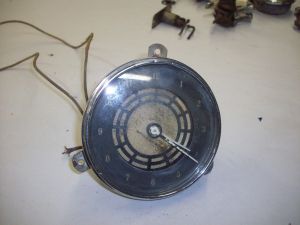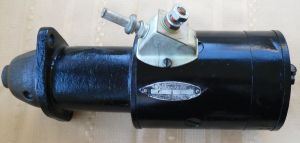- Home
- About Us
- Join/Renew
- Member Benefits
- Member Pages
- Log In
- Help
- Museum Store
Here is the assembled cross piece. Notice the dished brass washer on the 6 o’clock gear. Each gear has one.
Here are the spider gear parts exploded. You basically have a 4 axis cross piece with 4 (small)spider gears and concave brass washers on the outside and a pair of (larger)splined gears that the axle shafts slide into. These have brass thrust washers that fit between the gear and the carrier housing
David,
Thanks for putting me on to these guys. Whatever you picked up from your sources was good info. Thanks again.
Bill
Final report.
Axle shipped last Tuesday and arrived here today. No problems. They even let me dismantle it so I could get it in my car. Since they are restricted by floor space on the truck, not weight, the smaller the pallet the better, as far as costs go.
I must admit it worked very well, primarily due to the efforts of Bob Jacobsen and friend. Thanks every one. The worm gear actually turns on this one.
Bill
I answered my own interference fit question. The “Engineers Edge” says for bushings 3″ OD and less, the tolerance is .002-.003″ over the nominal size, then chilled prior to installation.
I also found bushing material at bronzebushings.com. Less than $70.
All I need now is a lathe.
Michael,
John’s clock might be the best option as the halo on the minute hand is unique. Item is 111279227582. Might be good to have a spare parts clock.
Bill

Michael,
My father in law was a watch maker and I have tons of stuff. Do you have a picture of what they look like or how long they are? Are they the same as a ’33?
Bill
Jak,
Thanks for the feedback. Relative to the snow. I used to live in Cleveland and the year it snowed in 9 consecutive Months I moved south to Atlanta. Last weekend I was on the coast and it was 65 degrees F. We have what we call the Mason- Dixon line here. Basically if you live north of it snow is an issue. South, not so much. My family has been here since the 1600’s and we were always south. Snow is a 4 letter word to be avoided at all cost. The problem I have is ice, which is a different kettle of fish.
Bill
Bill
Ed and Roger,
Thanks for the responses. I guess my concern is what was “gloss”” in 1933 vs “”chassis black”” in 2015.
Bill”
Jim,
The PASB 80-1 has drawings and part numbers for Models A, B, And C head, tail and cowl lights.
Bill
Jim,
I have never seen them (caveat emptor) and they are chrome plated brass, but Restoration Supply Company lists reflectors and other headlight parts up to 9 1/4″. That may be an option if you can’t find originals. If you are not happy with the chrome, since they are brass, I would think you could strip them and get them silvered if they fit.
What is the diameter of the headlight opening?
Benjamin,
Thank you very much for your post. I am always fascinated by posts that talk about the “Other” Pierce products, Ice Boxes, Wagons, cycles (both manpowered and horse powered),etc. I have been intrigued with the manufacturing complexity of companies in the early 1900’s. Hope to see more posts.
Bill
Something is odd. The above car is listed twice. One at $32,500 BIN and a new listing for $39,000 BIN. Chassis number is the same. I didn’t read the ads. Maybe there is some explanation within them.
The 739A comes up as a ’37 Chevy starter. The one in the above picture has 739A on the tag in the left box. I notice on the tag you have, there is only one field to stamp the numbers in , while the one above has 2 fields, left and right. Anyone know why? Both are Anderson, Ind. tags.
I can find no reference to a 739A fitting a PA. Can anyone else find a reference?
Looks like a ’37 Chevy Starter

Jim,
I checked and there are no restrictors or blocks in the pipe. Goes straight through.
Bill
Dean, they are intriguing. Air flow is from the right to the left. Intake on the right, exhaust on the left. What I have trouble with is how does the second steel layer keep from resonating against the other layers? I didn’t see any asbestos or other spacers or material.
And Jak, I am doing this with heavy gloves, respirator and glasses. The amount of rust would kind of lead you to believe the tetraethyl lead has been diminished. The Asbestos , on the other hand, is very much there and is breaking apart, so it will be dealt with and disposed of as a hazardous waste.
Jim,
Don’t know. I ‘lol check tomorrow.
Bill
For what it is worth, I did some excavation work on the 836 and was able to extract the remains of the muffler. Even though it is virtually rusted away, all the original clamps are there and the original mandrel ben head pipe is there. The muffler appears to be constructed as follows:
1. a perforated tube in the ID of the muffler, with cones on the OD (similar to what the Vet puts around a pets neck)
2. wrap of steel around the diameter of the cones.
3. another wrap of steel, I assume there is clearance
4. Asbestos wrap
5. Outer steel wrap.
Virtually all are seam crimped
I do a more careful analysis in the near future and have some dimensions.
Jim,
Where are they breaking? I have a fix i am working on for damaged threads. I am also on the trail of a caster in NC
Bill
